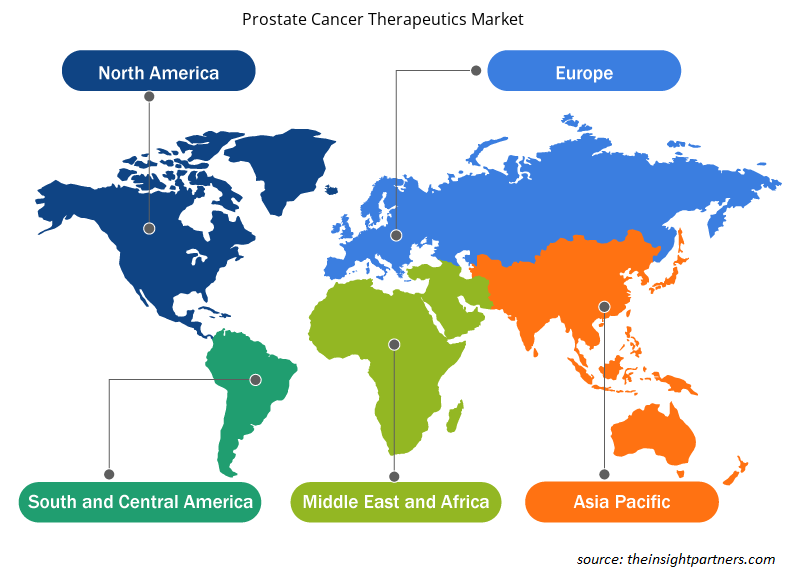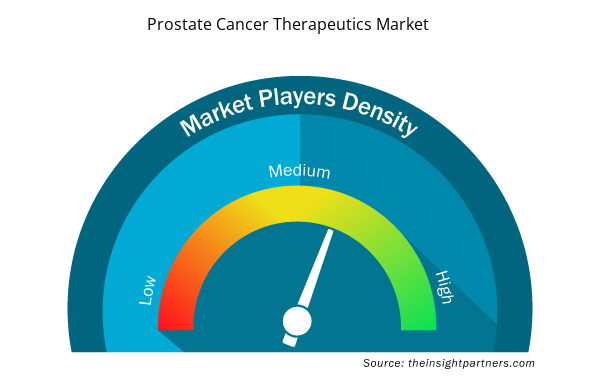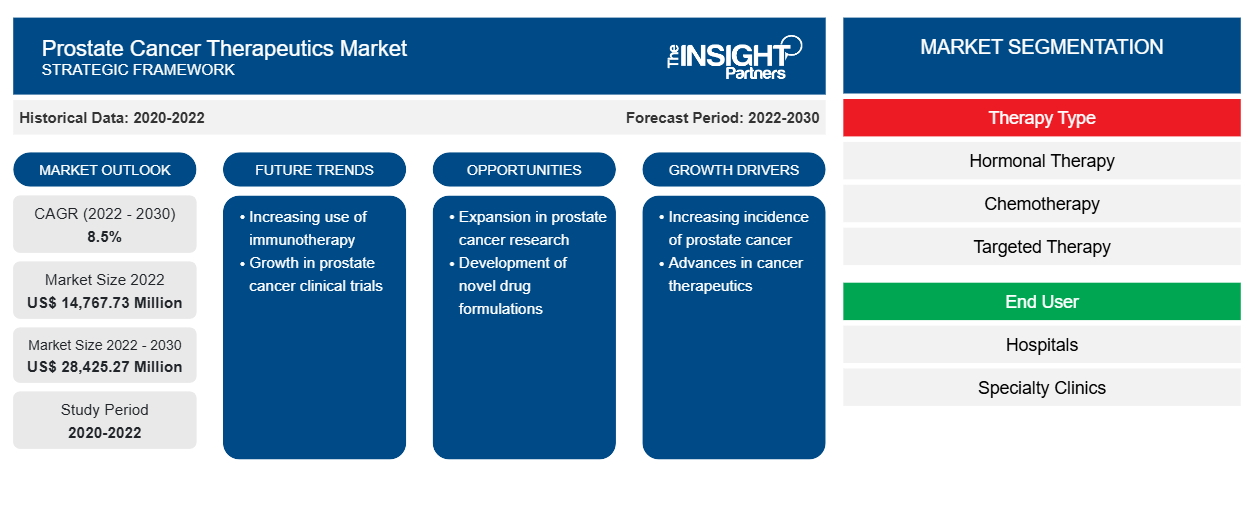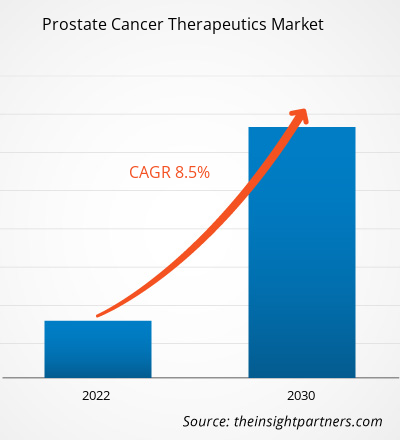[Rapporto di ricerca] Si prevede che il mercato delle terapie per il cancro alla prostata crescerà da 14.767,73 milioni di dollari nel 2022 a 28.425,27 milioni di dollari entro il 2030; si prevede che registrerà un CAGR dell'8,5% dal 2022 al 2030.
Approfondimenti di mercato e opinioni degli analisti:
Le dimensioni del mercato delle terapie per il cancro alla prostata si stanno espandendo con le crescenti attività di R&S per introdurre nuovi composti farmacologici, il crescente numero di casi di cancro alla prostata e il crescente sostegno governativo per la diagnosi del cancro alla prostata. Inoltre, la disponibilità di prodotti avanzati da parte degli operatori di mercato guida la crescita del mercato. A gennaio 2023, BDR Pharmaceutical ha lanciato una versione generica di Apalutamide che viene utilizzata per trattare il cancro alla prostata in India. Il farmaco è lanciato con il marchio APATIDE ed è prescritto per trattare il cancro alla prostata non metastatico resistente alla castrazione e il cancro alla prostata metastatico sensibile alla castrazione.
Fattori di crescita e sfide:
Il cancro alla prostata è uno dei problemi di salute più comuni negli uomini, soprattutto negli uomini anziani di età pari o superiore a 50 anni. Il cancro alla prostata è più comune negli uomini obesi e con una storia familiare di cancro alla prostata. Il cancro alla prostata è una minaccia silenziosa poiché spesso si sviluppa senza sintomi evidenti. Quindi, la diagnosi precoce di questo cancro non è così facile. La maggior parte dei tumori alla prostata ha origine nella regione periferica della ghiandola prostatica. Affinché i sintomi diventino evidenti, il cancro deve raggiungere una dimensione tale da esercitare pressione sull'uretra, oppure il dolore osseo dovuto alle metastasi potrebbe essere il sintomo iniziale di presentazione del cancro alla prostata avanzato in alcuni casi. Tuttavia, qualsiasi individuo di età pari o superiore a 50 anni che presenti sintomi del tratto urinario inferiore, disfunzione erettile o ematuria dovrebbe considerare la possibilità di cancro alla prostata. Il cancro alla prostata è la quinta causa di morte per cancro tra gli uomini in tutto il mondo e il secondo cancro più comunemente diagnosticato. Anche se c'è stata una diminuzione nell'incidenza del cancro alla prostata dal 2000, c'è un aumento nell'incidenza del cancro alla prostata in fase avanzata a partire dal 2010. I tassi di incidenza del cancro alla prostata e i tassi di mortalità differiscono notevolmente. Le nazioni sviluppate hanno generalmente un'incidenza più elevata di cancro alla prostata ma una mortalità inferiore. Il rischio di cancro alla prostata negli Stati Uniti è quasi quattro volte maggiore del rischio globale. Secondo Novartis AG, nel 2020, sono stati segnalati in tutto il mondo circa 1,4 milioni di nuovi casi di cancro alla prostata e circa 375.000 decessi per cancro alla prostata. Il numero crescente di casi di cancro alla prostata in tutto il mondo e il basso tasso di rilevamento del cancro alla prostata alimentano la crescita del mercato delle terapie per il cancro alla prostata.
Personalizza questo report in base alle tue esigenze
Riceverai la personalizzazione gratuita di qualsiasi report, comprese parti di questo report, o analisi a livello nazionale, pacchetto dati Excel, oltre a usufruire di grandi offerte e sconti per start-up e università
- Scopri le principali tendenze di mercato in questo rapporto.Questo campione GRATUITO includerà analisi di dati che spaziano dalle tendenze di mercato alle stime e alle previsioni.
Segmentazione e ambito del report:
Il mercato delle terapie per il cancro alla prostata è segmentato in base al tipo di terapia, all'utente finale e alla geografia. Il mercato delle terapie per il cancro alla prostata, in base al tipo di terapia, è segmentato in terapia ormonale, chemioterapia, immunoterapia, terapia mirata e altri. Il mercato delle terapie per il cancro alla prostata, in base all'utente finale, è segmentato in ospedali, cliniche specialistiche e altri. In base alla geografia, il mercato delle terapie per il cancro alla prostata è segmentato in Nord America (Stati Uniti, Canada e Messico), Europa (Regno Unito, Germania, Francia, Italia, Spagna e resto d'Europa), Asia Pacifico (Cina, Giappone, India, Corea del Sud, Australia e resto dell'Asia Pacifico), Medio Oriente e Africa (EAU, Arabia Saudita, Sud Africa e resto del Medio Oriente e Africa) e Sud e Centro America (Brasile, Argentina e resto del Sud e Centro America).
Analisi segmentale:
Il mercato delle terapie per il cancro alla prostata, per tipo di terapia, è suddiviso in terapia ormonale, chemioterapia, immunoterapia, terapia mirata e altri. Nel 2022, il segmento della terapia ormonale ha detenuto la quota di mercato maggiore dopo la chemioterapia e si prevede che lo stesso segmento registrerà il CAGR più elevato dal 2022 al 2030. La chemioterapia è considerata un trattamento importante per il cancro alla prostata. In questa terapia, i farmaci distruggono le cellule cancerose nuove o esistenti nei polmoni. La chemioterapia per il cancro alla prostata metastatico può alleviare i sintomi. Può anche aiutare a ridurre il cancro e migliorare la qualità della vita. Il docetaxel (Taxotere) è considerato lo standard di cura nella chemioterapia per il cancro alla prostata nei pazienti resistenti alla terapia ormonale. La FDA ha anche approvato il farmaco chemioterapico cabazitaxel (Jevtana) per il trattamento del cancro alla prostata resistente alla castrazione. Viene anche utilizzato per i pazienti affetti da cancro alla prostata metastatico che è cresciuto durante l'assunzione di docetaxel.
Analisi regionale:
Il mercato delle terapie per il cancro alla prostata è segmentato geograficamente in Nord America, Europa, Asia Pacifico, Medio Oriente e Africa e Sud e Centro America. Il Nord America è il maggiore contributore alla crescita del mercato globale delle terapie per il cancro alla prostata. Si prevede che l'Asia Pacifico registrerà il CAGR più elevato nel mercato delle terapie per il cancro alla prostata dal 2022 al 2030. La crescita del mercato delle terapie per il cancro alla prostata negli Stati Uniti è principalmente guidata dalla crescente incidenza di casi di cancro alla prostata, lanci di prodotti e iniziative governative. A giugno 2023, Lynparza (olaparib) di AstraZeneca e MSD in combinazione con prednisone o prednisolone e abiraterone è stato approvato negli Stati Uniti per il trattamento di pazienti adulti con sospetto carcinoma prostatico resistente alla castrazione metastatico (mCRPC) con mutazione BRCA deleteria (BRCAm). Inoltre, a novembre 2023, la FDA ha approvato enzalutamide, un prodotto prodotto da Astellas Pharma US, Inc. Il prodotto è utilizzato per il trattamento del carcinoma prostatico non metastatico sensibile alla castrazione (nmCSPC) con recidiva biochimica ad alto rischio di metastasi (BCR ad alto rischio).
Approfondimenti regionali sul mercato delle terapie per il cancro alla prostata
Le tendenze regionali e i fattori che influenzano il mercato delle terapie per il cancro alla prostata durante il periodo di previsione sono stati ampiamente spiegati dagli analisti di Insight Partners. Questa sezione discute anche i segmenti e la geografia del mercato delle terapie per il cancro alla prostata in Nord America, Europa, Asia Pacifico, Medio Oriente e Africa e Sud e Centro America.

- Ottieni i dati specifici regionali per il mercato delle terapie contro il cancro alla prostata
Ambito del rapporto di mercato sulle terapie per il cancro alla prostata
| Attributo del report | Dettagli |
|---|---|
| Dimensioni del mercato nel 2022 | 14.767,73 milioni di dollari USA |
| Dimensioni del mercato entro il 2030 | 28.425,27 milioni di dollari USA |
| CAGR globale (2022-2030) | 8,5% |
| Dati storici | 2020-2022 |
| Periodo di previsione | 2022-2030 |
| Segmenti coperti | Per tipo di terapia
|
| Regioni e Paesi coperti | America del Nord
|
| Leader di mercato e profili aziendali chiave |
|
Densità degli attori del mercato: comprendere il suo impatto sulle dinamiche aziendali
Il mercato dei prodotti terapeutici per il cancro alla prostata sta crescendo rapidamente, spinto dalla crescente domanda degli utenti finali dovuta a fattori quali l'evoluzione delle preferenze dei consumatori, i progressi tecnologici e una maggiore consapevolezza dei benefici del prodotto. Con l'aumento della domanda, le aziende stanno ampliando le loro offerte, innovando per soddisfare le esigenze dei consumatori e capitalizzando sulle tendenze emergenti, il che alimenta ulteriormente la crescita del mercato.
La densità degli operatori di mercato si riferisce alla distribuzione di aziende o società che operano in un particolare mercato o settore. Indica quanti concorrenti (operatori di mercato) sono presenti in un dato spazio di mercato in relazione alle sue dimensioni o al valore di mercato totale.
Le principali aziende che operano nel mercato della terapia del cancro alla prostata sono:
- Astella Pharma Inc
- Servizi Johnson & Johnson Inc.
- Eli Lilly e compagnia
- Bayer AG
- Sanofi
Disclaimer : le aziende elencate sopra non sono classificate secondo un ordine particolare.

- Ottieni una panoramica dei principali attori del mercato delle terapie contro il cancro alla prostata
Sviluppi del settore e opportunità future:
Di seguito sono elencate varie iniziative dei principali attori che operano nel mercato delle terapie per il cancro alla prostata:
- Nel marzo 2022, la FDA statunitense ha approvato Pluvicto (lutezio Lu 177 vipivotide tetraxetan) di Novartis per il trattamento di pazienti adulti affetti da un tipo di cancro alla prostata avanzato, denominato cancro alla prostata metastatico resistente alla castrazione positivo all'antigene di membrana prostatico specifico (mCRPC positivo al PSMA).
- Ad aprile 2023, la FDA ha concesso a Lantheus Holdings Inc e POINT Biopharma Global Inc la designazione fast track per 177Lu-PNT2002 per il trattamento del cancro alla prostata metastatico resistente alla castrazione (mCRPC). PNT2002 è un'innovativa terapia radiofarmaceutica a base di 177Lu mirata al PSMA che combina il ligando mirato al PSMA, PSMA-I&T e il radioisotopo beta-emittente 177Lu senza aggiunta di carrier per il trattamento del mCRPC.
Scenario competitivo e aziende chiave:
Astella Pharma Inc, Johnson & Johnson Services Inc, Eli Lilly and Company, Bayer AG, Sanofi, Merck KGaA, AstraZeneca, Novartis AG, AbbVie e Bristol Myers Squibb sono tra i principali attori che operano nel mercato delle terapie per il cancro alla prostata. Questi attori di mercato si concentrano sul lancio di nuovi prodotti e sulle espansioni geografiche per soddisfare la crescente domanda dei consumatori in tutto il mondo e aumentare la loro gamma di prodotti nei portafogli specialistici. La loro presenza globale consente loro di servire un'ampia base di clienti, facilitando successivamente l'espansione del mercato.
- Analisi storica (2 anni), anno base, previsione (7 anni) con CAGR
- Analisi PEST e SWOT
- Valore/volume delle dimensioni del mercato - Globale, regionale, nazionale
- Industria e panorama competitivo
- Set di dati Excel


- Mesotherapy Market
- Electronic Toll Collection System Market
- Pressure Vessel Composite Materials Market
- Batter and Breader Premixes Market
- Long Read Sequencing Market
- Webbing Market
- Artificial Intelligence in Healthcare Diagnosis Market
- Green Hydrogen Market
- Formwork System Market
- Integrated Platform Management System Market

Report Coverage
Revenue forecast, Company Analysis, Industry landscape, Growth factors, and Trends

Segment Covered
This text is related
to segments covered.

Regional Scope
North America, Europe, Asia Pacific, Middle East & Africa, South & Central America

Country Scope
This text is related
to country scope.
Domande frequenti
Based on geography, the prostate cancer therapeutics market is segmented into North America (the US, Canada, and Mexico), Europe (the UK, Germany, France, Italy, Spain, and the Rest of Europe), Asia Pacific (China, Japan, India, South Korea, Australia, and the Rest of Asia Pacific), the Middle East & Africa (the UAE, Saudi Arabia, South Africa, and Rest of the Middle East & Africa), and South & Central America (Brazil, Argentina, and the Rest of South & Central America). North America is the largest contributor to global prostate cancer therapeutics market growth. Asia Pacific is expected to register the highest CAGR in the prostate cancer therapeutics market from 2022 to 2030.
The prostate cancer therapeutics market, by therapy type, is segmented into hormone therapy, chemotherapy, immunotherapy, targeted therapy, and others. In 2022, the chemotherapy segment held the largest market share, and the same segment is expected to record the highest CAGR from 2022 to 2030.
The prostate cancer therapeutics market, by end-user, is segmented into hospitals, specialty clinics, and others. In 2022, the hospital segment held the largest market share; moreover, the same segment is expected to record the highest CAGR during 2022–2030.
The increasing cases of prostate cancer and strategic initiatives in prostate cancer therapeutics freezer bolster the prostate cancer therapeutics market size. However, the high cost associated with prostate cancer therapeutics hinders the growth of prostate cancer therapeutics market growth.
The prostate cancer therapeutics market majorly consists of players such Astella Pharma Inc, Johnson & Johnson Services Inc, Eli Lilly and Company, Bayer AG, Sanofi, Merck KGaA, AstraZeneca, Novartis AG, AbbVie, and Bristol Myers Squibb
Prostate cancer is one of the most common health problems in men, especially in older men (aged above 50 years). Prostate cancer is mostly common in men who are obese and have a family history of prostate cancer. Prostate cancer is a silent threat that often develops without noticeable symptoms, and hence, early detection of this cancer is not that easy. Typically, the majority of prostate cancers originate in the peripheral region of the prostate gland. Consequently, for symptoms to become apparent, the cancer must reach a size where it exerts pressure on the urethra, or in some cases, bone pain from the metastasis might be the initial presenting symptom of advanced prostate cancer. However, any individual aged 50 or above who presents with lower urinary tract symptoms, erectile dysfunction, or hematuria should consider the possibility of prostate cancer.
Trends and growth analysis reports related to Life Sciences : READ MORE..
The List of Companies - Prostate Cancer Market
- Astella Pharma Inc
- Johnson & Johnson Services Inc
- Eli Lilly, and Company
- Bayer AG
- Sanofi
- Merck KGaA
- AstraZeneca
- Novartis AG
- AbbVie
- Bristol Myers Squibb
The Insight Partners performs research in 4 major stages: Data Collection & Secondary Research, Primary Research, Data Analysis and Data Triangulation & Final Review.
- Data Collection and Secondary Research:
As a market research and consulting firm operating from a decade, we have published and advised several client across the globe. First step for any study will start with an assessment of currently available data and insights from existing reports. Further, historical and current market information is collected from Investor Presentations, Annual Reports, SEC Filings, etc., and other information related to company’s performance and market positioning are gathered from Paid Databases (Factiva, Hoovers, and Reuters) and various other publications available in public domain.
Several associations trade associates, technical forums, institutes, societies and organization are accessed to gain technical as well as market related insights through their publications such as research papers, blogs and press releases related to the studies are referred to get cues about the market. Further, white papers, journals, magazines, and other news articles published in last 3 years are scrutinized and analyzed to understand the current market trends.
- Primary Research:
The primarily interview analysis comprise of data obtained from industry participants interview and answers to survey questions gathered by in-house primary team.
For primary research, interviews are conducted with industry experts/CEOs/Marketing Managers/VPs/Subject Matter Experts from both demand and supply side to get a 360-degree view of the market. The primary team conducts several interviews based on the complexity of the markets to understand the various market trends and dynamics which makes research more credible and precise.
A typical research interview fulfils the following functions:
- Provides first-hand information on the market size, market trends, growth trends, competitive landscape, and outlook
- Validates and strengthens in-house secondary research findings
- Develops the analysis team’s expertise and market understanding
Primary research involves email interactions and telephone interviews for each market, category, segment, and sub-segment across geographies. The participants who typically take part in such a process include, but are not limited to:
- Industry participants: VPs, business development managers, market intelligence managers and national sales managers
- Outside experts: Valuation experts, research analysts and key opinion leaders specializing in the electronics and semiconductor industry.
Below is the breakup of our primary respondents by company, designation, and region:

Once we receive the confirmation from primary research sources or primary respondents, we finalize the base year market estimation and forecast the data as per the macroeconomic and microeconomic factors assessed during data collection.
- Data Analysis:
Once data is validated through both secondary as well as primary respondents, we finalize the market estimations by hypothesis formulation and factor analysis at regional and country level.
- Macro-Economic Factor Analysis:
We analyse macroeconomic indicators such the gross domestic product (GDP), increase in the demand for goods and services across industries, technological advancement, regional economic growth, governmental policies, the influence of COVID-19, PEST analysis, and other aspects. This analysis aids in setting benchmarks for various nations/regions and approximating market splits. Additionally, the general trend of the aforementioned components aid in determining the market's development possibilities.
- Country Level Data:
Various factors that are especially aligned to the country are taken into account to determine the market size for a certain area and country, including the presence of vendors, such as headquarters and offices, the country's GDP, demand patterns, and industry growth. To comprehend the market dynamics for the nation, a number of growth variables, inhibitors, application areas, and current market trends are researched. The aforementioned elements aid in determining the country's overall market's growth potential.
- Company Profile:
The “Table of Contents” is formulated by listing and analyzing more than 25 - 30 companies operating in the market ecosystem across geographies. However, we profile only 10 companies as a standard practice in our syndicate reports. These 10 companies comprise leading, emerging, and regional players. Nonetheless, our analysis is not restricted to the 10 listed companies, we also analyze other companies present in the market to develop a holistic view and understand the prevailing trends. The “Company Profiles” section in the report covers key facts, business description, products & services, financial information, SWOT analysis, and key developments. The financial information presented is extracted from the annual reports and official documents of the publicly listed companies. Upon collecting the information for the sections of respective companies, we verify them via various primary sources and then compile the data in respective company profiles. The company level information helps us in deriving the base number as well as in forecasting the market size.
- Developing Base Number:
Aggregation of sales statistics (2020-2022) and macro-economic factor, and other secondary and primary research insights are utilized to arrive at base number and related market shares for 2022. The data gaps are identified in this step and relevant market data is analyzed, collected from paid primary interviews or databases. On finalizing the base year market size, forecasts are developed on the basis of macro-economic, industry and market growth factors and company level analysis.
- Data Triangulation and Final Review:
The market findings and base year market size calculations are validated from supply as well as demand side. Demand side validations are based on macro-economic factor analysis and benchmarks for respective regions and countries. In case of supply side validations, revenues of major companies are estimated (in case not available) based on industry benchmark, approximate number of employees, product portfolio, and primary interviews revenues are gathered. Further revenue from target product/service segment is assessed to avoid overshooting of market statistics. In case of heavy deviations between supply and demand side values, all thes steps are repeated to achieve synchronization.
We follow an iterative model, wherein we share our research findings with Subject Matter Experts (SME’s) and Key Opinion Leaders (KOLs) until consensus view of the market is not formulated – this model negates any drastic deviation in the opinions of experts. Only validated and universally acceptable research findings are quoted in our reports.
We have important check points that we use to validate our research findings – which we call – data triangulation, where we validate the information, we generate from secondary sources with primary interviews and then we re-validate with our internal data bases and Subject matter experts. This comprehensive model enables us to deliver high quality, reliable data in shortest possible time.


 Ottieni un campione gratuito per questo repot
Ottieni un campione gratuito per questo repot